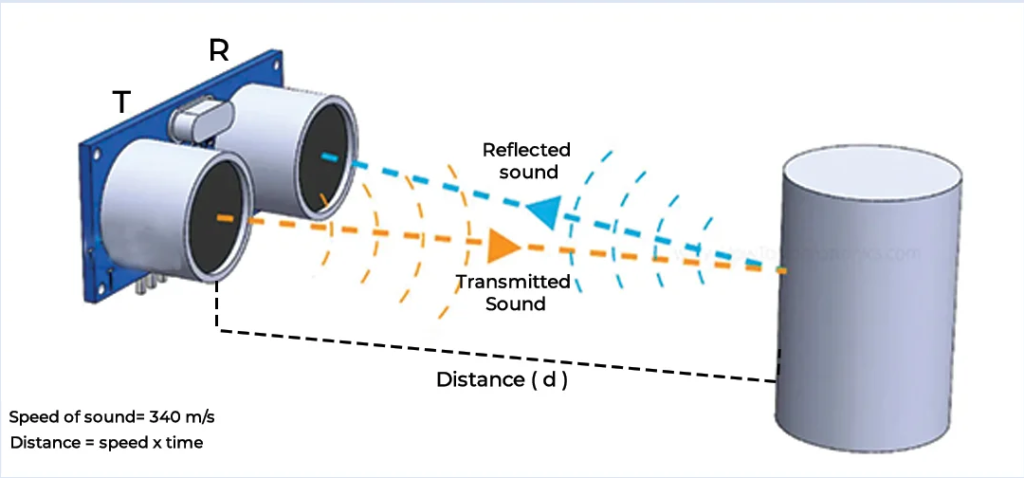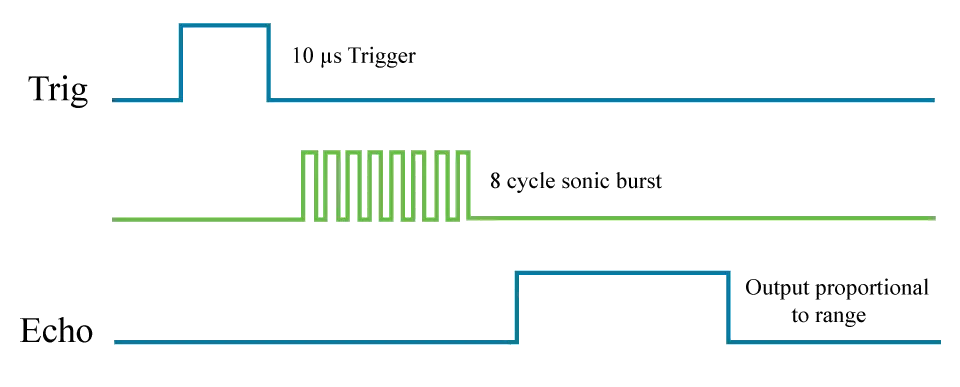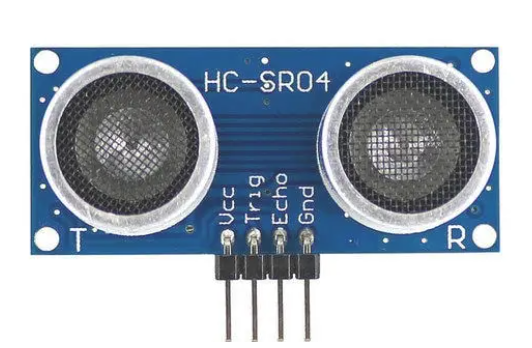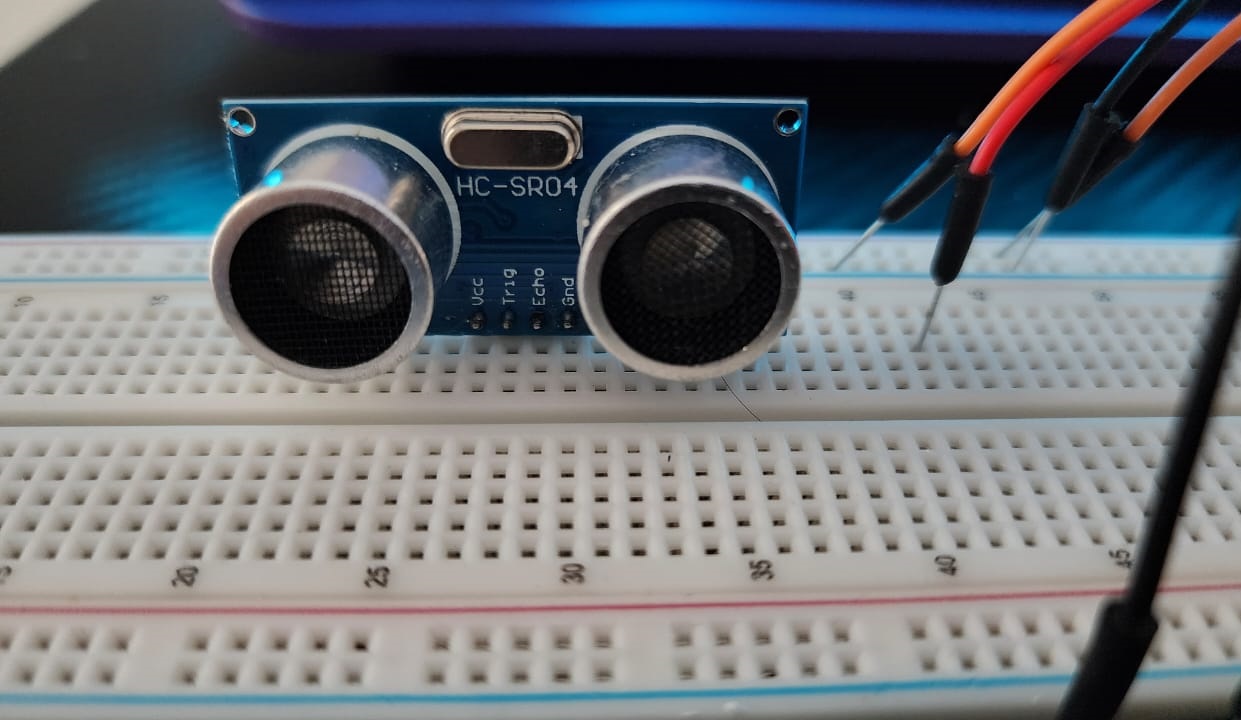The HC-SR04 Ultrasonic Sensor is a popular sensor module used for measuring distance with the help of ultrasonic waves. It’s widely used in robotics, automation, and various DIY projects. HC-SR04 sensor operates on a principle similar to SONAR (Sound Navigation and Ranging) technology used in submarines. It consists of two ultrasonic transducers: a transmitter (The sensor emits ultrasonic waves from its transmitter) and a receiver (It then waits for the waves to bounce back. The receiver detects these waves when they return after hitting an object).
Here’s how it generally works:
The HC-SR04 Sensor emits ultrasonic waves at a frequency of around 40,000 Hz (though the actual frequency may vary slightly). These waves travel through the air until they encounter an object in their path. Upon hitting the object, the waves bounce back to the sensor.

By measuring the time, it takes for the ultrasonic pulse to travel to the object and return, and knowing the speed of sound in air (approximately 340 meters per second at room temperature), you can accurately calculate the distance between the sensor and the object.
To initiate the ultrasound emission, we set the Trig pin to a High state for 10 microseconds. This action triggers the transmission of an 8-cycle ultrasonic burst, traveling at the speed of sound. Immediately after sending this burst, the Echo pin goes high, indicating its readiness to receive the reflected wave from any objects in the vicinity.

If there’s no object or reflected pulse detected, the Echo pin will return to a low state after 38 milliseconds due to a timeout. If there is a reflected pulse, causes the Echo pin to transition to a low state before the 38-millisecond timeout. By measuring the duration for which the Echo pin remains HIGH, we can ascertain the distance traveled by the sound wave, and consequently, the distance from the sensor to the object.
The formula for calculating distance using the HC-SR04 sensor is:
Distance = (Time taken by the wave to return x Speed of sound) / 2
This formula divides the time by 2 because the wave travels from the sensor to the object and back again, so the total distance traveled is twice the distance between the sensor and the object.
Here is the example of calculation:
Assuming the speed of sound is approximately 340 meters per second, and converting the time to seconds:
Distance = (0.025 seconds * 340 m/s) / 2
Distance = 8.5 meters / 2
Distance ≈ 4.25 meters

The HC-SR04 sensor typically has four pins:
- VCC: Power supply pin (usually 5V)
- Trig (Trigger): This pin is used to trigger the sensor to send out an ultrasonic pulse.
- Echo: This pin receives the ultrasonic pulse after it has bounced off an object.
- GND: Ground pin.
Here is a concise summary of its characteristics:
- Power Supply: +5V DC
- Quiescent Current: <2mA
- Working Current: 15mA
- Effectual Angle: <15°
- Ranging Distance: 2cm – 400 cm
- Resolution: 0.3 cm
- Measuring Angle: 30 degrees
- Trigger Input Pulse width: 10uS TTL pulse
- Echo Output Signal: TTL pulse proportional to the distance range
- Dimensions: 45mm x 20mm x 15mm
You can interface the HC-SR04 sensor with microcontrollers like Arduino, Raspberry Pi, or any other microcontroller that supports GPIO (General Purpose Input Output). By reading the signal from the Echo pin, you can measure the time taken for the ultrasonic pulse to return, and hence calculate the distance using the formula mentioned above. The HC-SR04 ultrasonic sensor is widely used in applications owing to its precision in distance measurement using sound waves.
Here’s a breakdown of some prevalent uses:
- Robotics: Within robotics, it serves purposes such as obstacle detection, evasion, pathfinding, and environment mapping.
- Speed and Direction Measurement: The sensor is adept at determining speed and direction between two entities.
- Medical Appliances: It finds application in medical ultrasonography, offering a non-invasive means to examine the body.
- Burglar Alarms: Integrating the sensor into security setups enables intruder detection.
- Sonar Systems: Underwater, it aids sonar equipment in object detection.
- Humidifiers: In the realm of humidifiers, it aids in gauging water levels.
- Wireless Charging: The sensor plays a role in aligning devices for efficient wireless charging.
- Non-Destructive Testing: Its utilization in inspecting materials and structures without causing harm proves invaluable.
These applications capitalize on the sensor’s non-contact detection capabilities, delivering both safety and convenience across diverse domains. While the HC-SR04 Ultrasonic Sensor is a versatile and widely used component for distance measurement in various projects, it does have some limitations.
Here are the constraints or limitations on its usage:
- Limited Range: The HC-SR04 sensor has a maximum range typically around 2 meters, beyond which accuracy decreases.
- Blind Spots: The sensor may struggle to detect objects with irregular shapes or surfaces that absorb sound waves, leading to blind spots in detection.
- Angle Dependency: Accuracy may vary based on the angle of incidence of the sound waves, affecting the reliability of distance measurements.
- Interference: Environmental factors such as noise and other ultrasonic sources can interfere with sensor readings, potentially leading to inaccuracies.
- Temperature Sensitivity: The speed of sound in air, which the sensor relies on for distance calculation, can vary with temperature, affecting measurement accuracy.
- Resolution: The sensor’s resolution may not be fine enough for applications requiring precise distance measurements, as it typically provides distance readings in centimeters.
- Limited Functionality in Certain Conditions: HC-SR04 may encounter challenges in highly reflective or absorbent environments, affecting its performance.
Despite these limitations, the HC-SR04 Ultrasonic Sensor remains a cost-effective and popular choice for many applications due to its simplicity, ease of use, and suitability for various DIY projects and educational purposes.
Expertise on Engineering.
Robotic and microcontroller are like toys to me.
I love playing with them.
